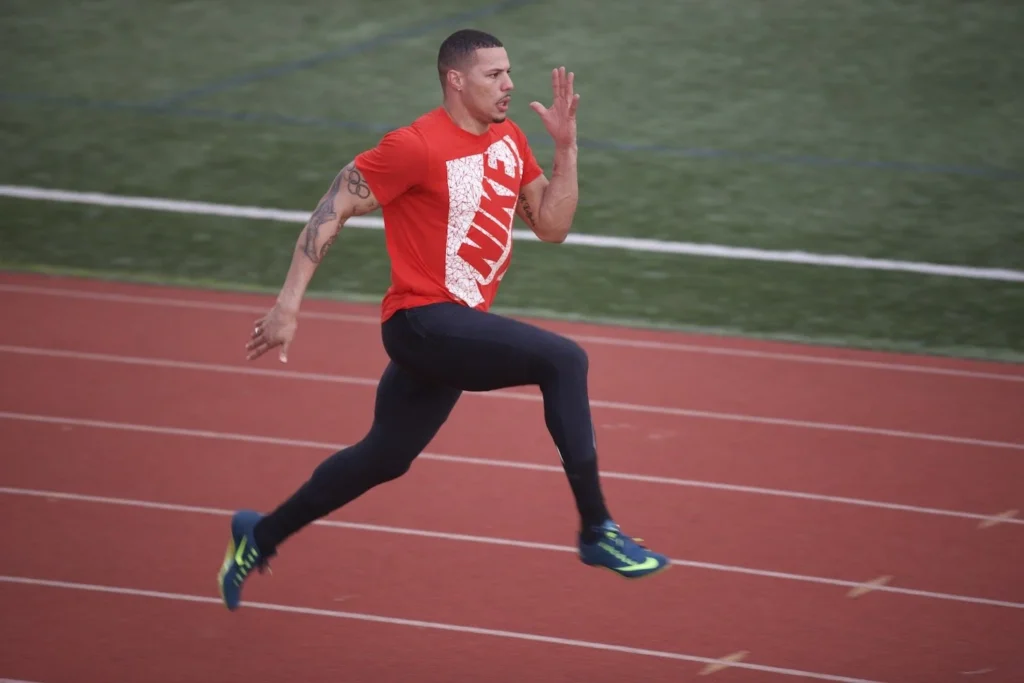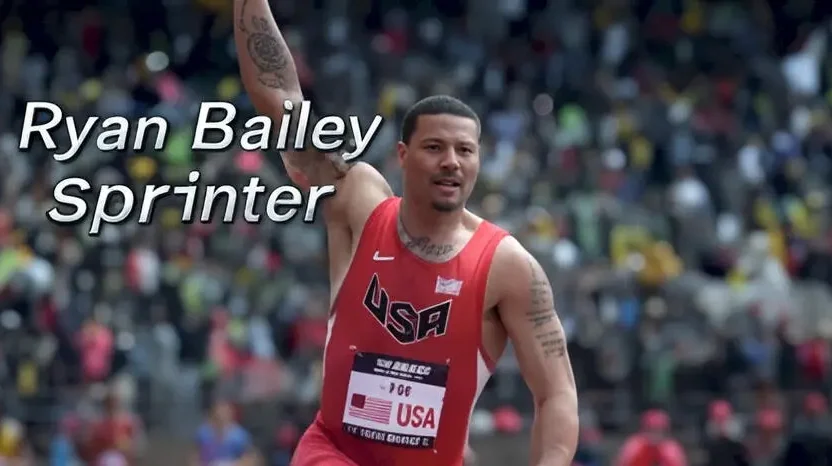The journey of an elite athlete is often one of dedication, resilience, and incredible speed. For Ryan Bailey sprinter, this story includes overcoming a turbulent youth, battling injuries, and reaching the pinnacle of track and field. Born on April 13, 1989, in Portland, Oregon, Bailey’s path to the Olympic stage was anything but ordinary.
He emerged from a challenging background to become one of America’s top sprinters, known for his imposing height and powerful late-race surge. This article dives into the life and career of Ryan Bailey, exploring his rise in the athletics world, his achievements, and the personal details that have shaped his journey.
Table of Contents
Who is Ryan Bailey Sprinter?
Ryan Bailey is an American track and field athlete specializing in sprint events. He captured national attention with his remarkable performances in the 100-meter and 200-meter dashes. His story is particularly inspiring due to the obstacles he overcame. Growing up in Salem, Oregon, Bailey navigated a difficult childhood and adolescence. However, he found his calling on the track at Douglas McKay High School, where his natural talent for sprinting began to shine through.
His high school success was a sign of things to come. He won state championships and began to make a name for himself on the national junior circuit. Despite his raw talent, his path wasn’t a straight line to professional sports. He attended Chemeketa Community College and later Rend Lake College, a junior college known for its strong track and field program. It was here that the Ryan Bailey sprinter phenomenon truly began to take shape, setting records and proving he had the potential to compete with the world’s best.
From High School Star to Professional Athlete
Bailey’s transition from a high school champion to a professional athlete was marked by key decisions and standout performances. At McKay High School, he secured Oregon State 6A titles in both the 100 and 200 meters in 2007, signaling his dominance at the state level. He continued to compete at a high level, placing well in national junior championships.
His time at Rend Lake College was a critical turning point. He won the 55-meter dash at the National Junior College Indoor Championships and later claimed the 100-meter title at the outdoor championships with a national junior college record time of 10.05 seconds. This performance made him one of the fastest American sprinters in 2009.
Recognizing his immense potential, he turned professional in August 2009, signing a contract with Nike and dedicating himself fully to his sprinting career. This move allowed him to train with elite coaches and compete against top-tier talent on the international circuit.

Ryan Bailey Sprinter Height and Physical Build
One of the most notable attributes of Ryan Bailey sprinter is his impressive physical stature. Standing at 6 feet 4 inches (193 cm), the ryan bailey sprinter height sets him apart from many of his competitors. In a sport often dominated by more compact, explosive athletes, Bailey’s tall frame gives him a unique advantage, particularly in the latter stages of a race.
His long stride allows him to cover more ground with each step, which contributes to his powerful finishing kick. While a taller frame can sometimes be a disadvantage out of the starting blocks, Bailey has worked hard to refine his start to complement his top-end speed. His build, combined with his natural athletic gifts, has often drawn comparisons to the legendary Usain Bolt, another tall sprinter who redefined the limits of speed.
How Height Impacts a Sprinter’s Performance
A sprinter’s height can be both a blessing and a curse. Here’s a breakdown of its impact:
- Longer Strides: Taller sprinters like Bailey naturally have a longer stride length, meaning they can cover the 100-meter distance in fewer steps than shorter athletes.
- Top-End Speed: The combination of stride length and stride frequency determines speed. While shorter sprinters may have a higher frequency, the ground covered by a taller athlete’s stride can lead to incredible top-end speed.
- The Start: The biggest challenge for a tall sprinter is the start. Uncoiling a larger frame from the starting blocks requires immense power and technique to match the explosive starts of shorter competitors.
- Leverage: Longer limbs can generate more force, which is beneficial once the sprinter reaches their upright running phase.
Bailey’s career is a testament to how a tall athlete can harness their physical attributes to excel in the shortest and most explosive events in track and field.
The 2012 London Olympics: A Global Debut
The peak of his career came at the 2012 Summer Olympics in London. Representing the United States, Bailey stepped onto the world’s biggest stage and proved he belonged among the elite. He qualified for the team by finishing third in the 100-meter final at the U.S. Olympic Trials with a swift time of 9.93 seconds.
In London, Bailey made an immediate impact. He won his opening heat in the 100 meters, clocking a time of 9.88 seconds and equaling his personal best. He advanced through the rounds to reach the highly anticipated 100-meter final. In a race for the ages, Bailey once again ran 9.88 seconds, a remarkable display of consistency, to finish in fourth place.
Though just outside the medals, his performance solidified his status as one of the fastest men on the planet. He also anchored the U.S. 4×100 meter relay team, which initially won a silver medal before it was later rescinded.
Life After the Olympics and Career Progression
Following the London Olympics, Ryan Bailey continued to compete on the international circuit, but his career was frequently hampered by injuries. A series of physical setbacks, including foot and heel fractures, prevented him from consistently building on his Olympic success. These injuries often derailed his training and preparation for major championships, making it difficult to maintain the form that saw him rise to the top.
Despite these challenges, he showed flashes of his brilliant speed. In 2015, he ran a blistering 6.50 seconds in the indoor 60-meter dash, the fastest time by an American that year. This performance hinted at what could have been if he had remained healthy. Later in his career, Bailey even explored a different sport, trying his hand at bobsledding in 2016. He won the brakeman title at the U.S. National Push Championships, showcasing his raw power and athletic versatility.
Ryan Bailey’s Personal Bests and Achievements
Throughout his career, Ryan recorded some exceptional times that place him among the best in American history. His ability to perform under pressure at major events is a key part of his legacy.
Personal Bests:
- 100 Meters: 9.88 seconds (Rieti 2010, London 2012)
- 200 Meters: 20.10 seconds (Zürich 2010)
- 60 Meters (Indoor): 6.50 seconds (Seattle 2015)
His 100-meter personal best of 9.88 seconds makes him one of the fastest Americans in the history of the event. He achieved this time on multiple occasions, demonstrating his ability to consistently produce world-class speed. His 20.10-second 200-meter time is also highly respectable, highlighting his versatility across the short sprints.
Key Achievements:
- 2012 Olympian (4th place in 100 meters)
- 2015 IAAF World Relays Gold Medalist (4×100 m relay)
- 2009 NJCAA 100-meter Champion
- 2009 NJCAA Indoor 55-meter Champion
Understanding the Ryan Bailey Sprinter Net Worth
Estimating the net worth of a track and field athlete can be complex, as it depends on prize money, endorsements, and appearance fees. While specific, verified figures for the ryan bailey sprinter net worth are not publicly available, we can analyze the typical income streams for an athlete of his caliber.
Elite sprinters earn money from several sources. Winning races in the Diamond League circuit comes with significant prize money. Appearance fees for competing in prestigious meets also contribute a large portion of their income. The most lucrative opportunities, however, come from endorsement deals. Bailey’s contract with Nike, signed in 2009, would have been his primary source of income for many years.
Athletes who compete in the Olympics often see their earning potential increase due to heightened visibility. Given his Olympic appearance and top-level performances, it’s reasonable to assume the ryan bailey sprinter net worth was substantial during his peak years, likely reaching into the high six figures or more.
Personal Life: Is There a Ryan Bailey Sprinter Wife?
Details about Ryan Bailey’s personal life, including his relationships, are largely kept private. There is no publicly available information confirming a ryan bailey sprinter wife or his current marital status. Bailey has focused most of his public persona on his athletic career and the challenges he has overcome.
Athletes in the public eye often choose to keep their family and personal relationships out of the spotlight to maintain a sense of privacy. Bailey’s story has primarily centered on his journey from a difficult youth in Oregon to becoming an Olympic sprinter.
He has been open about his past struggles and how track and field provided him with a positive outlet and a path forward. This narrative of perseverance, rather than details about a ryan bailey sprinter wife, has been the focus of his public journey.
Key Takeaways
- Overcame Adversity: Ryan Bailey’s journey is a powerful story of overcoming a challenging youth to achieve greatness on the world stage.
- Impressive Stature: At 6’4″, Bailey’s height gave him a unique advantage with a long, powerful stride, making him a formidable finisher.
- Olympic Finalist: He reached the pinnacle of his sport by finishing fourth in the 100-meter final at the 2012 London Olympics with a time of 9.88 seconds.
- Injury Struggles: His post-Olympic career was marked by a series of injuries that prevented him from consistently reaching his peak form.
- Versatile Athlete: Beyond sprinting, Bailey showcased his athleticism by winning a national bobsledding championship as a brakeman.
Frequently Asked Questions (FAQ)
What is Ryan Bailey’s fastest 100m time?
Ryan Bailey’s fastest official 100-meter time is 9.88 seconds. He achieved this personal best in Rieti, Italy, in 2010 and equaled it twice during the 2012 London Olympics.
How tall is Ryan Bailey?
The ryan bailey sprinter height is 6 feet 4 inches (193 cm), making him one of the taller sprinters in elite track and field.
Did Ryan Bailey win an Olympic medal?
Ryan Bailey was part of the U.S. 4x100m relay team that initially won a silver medal at the 2012 London Olympics. However, the medal was later stripped from the team due to a teammate’s doping violation that occurred before the games. He finished fourth in the individual 100-meter final.
What is the estimated ryan bailey sprinter net worth?
While exact figures are not public, the ryan bailey sprinter net worth during his peak was likely significant, built from his Nike sponsorship, prize money, and appearance fees.
Is Ryan Bailey married?
There is no public information confirming that Ryan Bailey is married. He has kept his personal life, including details about a potential ryan bailey sprinter wife, very private.

Leave a Reply